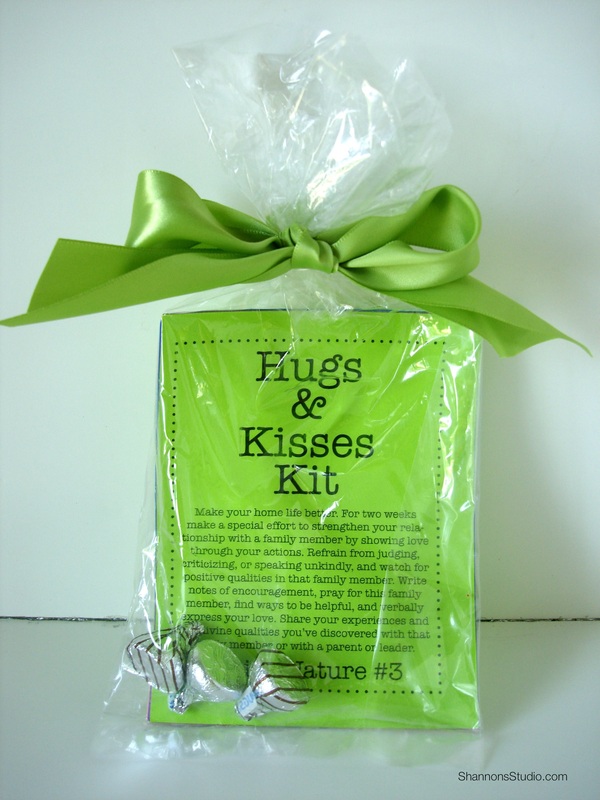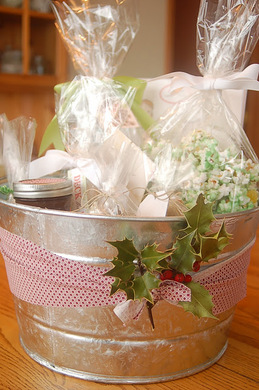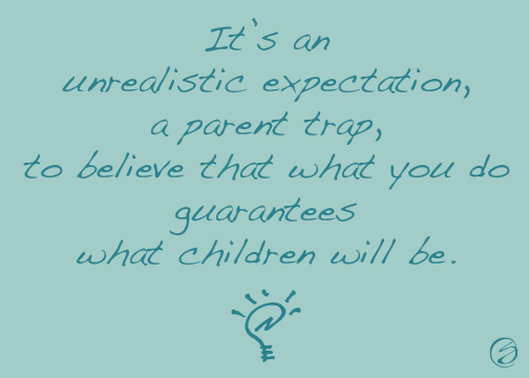Family Fitness in 36 SecondsOne act. Three seconds. Twelve times. Equals 36 seconds a day. What’s the magic moment? A hug. According to family therapist Virginia Satir, “The recommended daily requirement for hugs is: 4 per day for survival, 8 per day for maintenance, and 12 per day for growth.” A family’s emotional fitness can be aided by a mere 36 seconds a day. But, the real trick, says neuroeconomist Paul J. Zak, is that the hug has to be associated with a “signal of trust”. Having some sign of confidence in the relationship, or potential connection, accompanied with the hug insures moods more at peace, security increased, and stress released. Efforts can be made to remind us, and family members, of the 36-second hug habit. To strengthen the attachment process and hug therapy in your home I made 2 versions of the Hugs & Kisses Kit. (I threw in the kisses for good measure.) The idea is that the kit has chocolate candies and every time one is taken out, then a hug has to be given to someone as ‘payment’. The kit really isn’t necessary, just a fun reminder to get your family counting and keeping track of heart healthy hugs. Here are a few other times to wrap your head (and arms) around. • hug in morning • hug at night • hug to greet • hug to congratulate • hug to warm • hug to protect • hug to connect • hug to apologize • hug to energize • hug to support • hug to strengthen • hug to surprise Thirty six seconds to increase family fitness of heart and mind. Do you have the time today? Get the DIY downloadable here @ Idaho Women's Journal for $2.
There's a crafty version and a quick version. I had the quick version of the Hugs & Kisses glass jar out during a party and there were hugs everywhere. Try it out in your home and let me know how you like it.
5 Comments
1) Do acknowledge them Hello. Talk to them when they come in. Show some interest. Get to know them. 2) Do show respect Grow up. Kids want to be treated like an adult, this is one area in which that works. 3) Do provide food Yum. Food always works. Feed them. Even let them have access to the kitchen. 4) Do be some fun Duh. Do something unexpected from the normal routine. Be a little playful. 5) Do avoid confrontations Yield. This isn't the time to correct your kid. Do that later, where you can discuss. 6) Do remember them Notice. Names, siblings, & unique things about them. Also, how your kid knows them. 7) Do make it peaceful Zen. An environment that's void of contention makes a place people want to be. 8) Do leave a little space Exit. Give them some room. Not the bedroom. But, some talking space to be private. 9) Do like them Enjoy. Everyone has annoyances. Overlook them. See what your kid sees. Be open. 10) Do keep long hours Nap. It doesn't have to be 'open all night' but kids like late nights. Especially weekends. Bonus: Do treat them like family Include. Everyone wants to belong. Somewhere. Make it you and yours that they think of as 'family' when they need to connect. How you interaction with your kid's friends, and your kid, will benefit everyone. What do you do?
10 Don'ts When Interacting with Your Teen's Friends 1. Don't try to be cool. Awkward. And painful. It never works when a parent tries to be cool. 2. Don't compete. Loser. You lose when you make it about competing with your kid. Join a ball team. 3. Don't make fun. Ever. Never use your kid (or their friends) as the punch line for a joke. Laugh at something else. 4. Don't always jump in. Know-it-all. Let them figure a few things out. You don't always have to share the answers. 5. Don't look for friends. Creepy. Don't make your kids friends your friends. On FB or at home. Find your own. 6. Don't be pushy. Bully. It doesn't have to be my way or the high way. Let some things ride. 7. Don't be fake. Phony. Embrace & express who you are & be authentic. No need to use a bull horn. 8. Don't take over the conversation. Windbag. Be a small part of the conversation, don't be the conversation. Sometimes, don't even talk. 9. Don't be sensual. Ewe. Do I even need to say anything? Sadly, yes. Turn your sexual brain off. Period. 10. Don't try to outshine. Diva. The spotlight shouldn't be on you or how you feel. Your kid is the star. Bonus: Don't embarrass. Jerk. This isn't about you. Then, again, it's all about you. Kids don't want to be embarrassed at all costs. You have the power to make sure that doesn't happen to them, or their friends. Make them comfortable, and keep them coming around. You won't end up being the jerk parent, or any of the above kind either. What other "don't" would you add to the list?
At church we have a program for young women (12-18 years) to develop character. They have various activities they can perform. One of the experiences they get to have is a chance to "strengthen your relationship with a family member by showing love through your actions". To help the girls I made up this Hugs & Kisses Kit. I did this around Father's Day so the girls could have a chance to focus on their relationship with their Dad if they wanted to. Since it's close to Father's Day I thought I'd share it with you. This activity lasts two weeks so I gave simple suggestions of what they can do to interact each day. Some of the activities are Day #7 Make a treat for this person, Day #11 Text a nice comment to this person, Day #2 Find out their favorites, Day #8 Talk about your favorite things to do in Summer. I designed these into 1/4 sheet handouts. They can put it on a ring to help them remember. I call it The Ring Thing™. I've made several for different topics to go on the Ring Thing which I'll share periodically. Here's a photo of my Ring Thing. Here's a PDF to download if you'd like to use it for some activity you have. It's a black and white PDF that you can print onto colored paper. Then you can cut it into 1/4 sheets.
Did a little surfing down memory lane and came across an article that I contributed to a long time ago and forgot about. It was about TV viewing and what can be done to curb the amount of time watching it. (We've never been big television watchers. There's just so many other really fun things to do.) I'm glad to report the things I said yesterday (relatively speaking) are still valid today. You can see if you agree.
If you've got going back to school on your mind, here is an article at OnlineSchools.com that might give you some inspiration. It also happens to quote me and tell a little about my experience going back to school. (I'll share a few more tips another day, after I know which ones aren't going to be used for another article.) Going back to school was really hard but very worth it. An investment in me and our family.
PS Other articles I've contributed to. Well, yesterday I talked about gift giving. Today I have something else on my mind. This morning I read an article about a NYC public school teacher who told her class of second graders, during a geography lesson, that there was no Santa. She was discussing the North Pole and the children assured the teacher they knew where the it was because Santa lived there. The teacher decided to clarify that myth and said that there was no Santa. Also, she felt a need to tell them that it was their parents who put presents under the tree for them, not Santa. What exactly that had to do with geography I don't know. After the article, there ensued a back and forth in the comments section about whether kids should be told the truth, if they should even be told to believe in Santa at all, and every opinion in between. I have issues with Santa myself. I've never told my kids there was and never told them there wasn't. When they asked me I would always respond with, "What do you think?" Sometimes they'd say what they thought and sometimes they didn't. I let them talk. So, the belief in the man Santa has been perpetuated very little, if at all, in our home. But, the spirit of Santa and Christmas has. As an artist I'm very aware of symbols and their use. We use symbols in society all the time. Santa Claus is a symbol. A collective symbol of the intangible attributes of joy, wonder, mystery and surprise that we have few other means to share and pass on. For most of society we have mutually agreed to do that. Just as we've nationally decided that the American Flag is a symbol of patriotism, wedding rings a symbol of fidelity and love, and yellow ribbons a welcoming back home. Whether we choose to embrace these icons and the ideas they represent are personal choices. A lot of times people get so emotional that they miss the mark about what the problem is. The real issue with this situation is that this teacher believed, and acted on the idea, that it was her RIGHT to tell these children. She decided that Teacher usurps Parent. Put another way, Teacher displaces, supplants, confiscates, or cuts out Parent. This is a policy that is being perpetuated in some schools - teacher has more right than a parent to decide - on many issues like gender, sex, and religion. The problem with not seeing the core issue is that Parent then relinquishes, surrenders ands hands over their right to Teacher. This teacher decided in that moment, without care, concern, nor consensus of others, that she would take on the role of Parent. In her "truth-telling" did she really have regard about how the truth was told? How the children might respond to it? That it might shatter their (not her) belief system? Is this truth age appropriate? Did she let parents know that she would be busting this tradition so that they could be prepared for the aftermath? Did she let the parents know after the fact with a note home? Did she teach about symbols in society? Did she teach about the different methods of gift giving? Did she teach about celebrations? Did she teach any historical context? These are things a real parent are concerned with. That differentiates Teacher and Parent. This teacher didn't care enough about the children, nor was she willing to take on the real role of parent, to consider the outcome and welfare for those children. I for one want to be a real parent, not some make-believe one that this teacher is trying to be.
I can't believe it's December. DECEMBER. This so snuck up on me this year. As you know, it's the gift giving season! So I'm thinking about gifts, what fun they are and that I need to get busy getting mine together. One of my favorite types of gifts to get/give are kits. (ok, besides the expensive jewelry, clothes, and art categories.) Kits are so delightful. They're a surprise within a surprise. I love the feeling of being surprised again and again as I look through what was put into the kit. Friendship Bracelet Kit • A To Do Kit • (click image for link) Kits can be designed around any conceivable topic or theme. Like a Snowman Kit. Who knew I wanted a Snowman Kit. It's about as creative as you want to be. Snowman Kit • How totally clever! (click image for link) And kits don't have to be expensive. Which is such a bonus. Some of the items might not be so great on their own (like embroidery thread) but when combined with other inexpensive items and packaged up in a fun way it says I care. Which is what gift giving is all about. They can also be done straight from home. Like from your own kitchen. How convenient! Goodies Kit • Baked Goods in Cello Bags • click image for link I've already created one kit for one of my kids on a regular shopping trip. You can create a kit too. You don't even have to think up your own kit contents, there are so many great ones out there already. I have a whole pin board of them, so you can go here and just pick an idea out. Remember it's December, the gift giving season.
I have 8 children and have been in a waiting room (or stuck at some other unforeseen place) a time or two with a toddler. In fact, often with several toddlers at a time. I found that these situations were not just the regular-boring-kind but the outburst-boring-kinds for kids. One of the things that worked for me was the Mini Kid Kit. It was just a small bag in my purse that had travel size things, (tiny flashlight, metal play keys, mirror, bracelet, heavy necklace, hair clip, etc), items they never got to play with under normal conditions. Basically, anything that they were curious in and weren't allowed to play with; or small toys that they usually couldn't touch because they were "mine", kept their interest when they were outburst-bored in a public place. It helped to keep them quiet on many occasions. This helped me not become the outburst mommy of the outburst toddler. If I felt like there was something in my power to do I became less frustrated and more in control of the situation. Toddlers, especially on the verge of tantrums, definitely need a mom in control of herself and the situation. The Mini Kid Kit was a tool for me to do that. But there are 3 keys to the Mini Kid Kit 1) You don't give the child the whole bag, bring out items one at a time 2) They don't see the bag in its entirety so they don't fuss for the next item before they've explored the first 3) You take away the toy (and give them the next one) before they get bored with it Rotate and re-rotate them around. Hopefully, this little tip will help you. Go ahead. Grab a ziplock bag, add a few things in it, and put it in your purse. Done.
I do not know where people, religious people in particular, get this idea in parenting but it exists - If we do this (whatever it is) then we are guaranteed to get that (whatever is attached to this). Okay, I kinda do know where the idea comes from, religiously speaking. But, how did we start applying it to parenting? And in "apply it to parenthood" I mean - If I do 'this' then my kids will (guarantee) to do/get 'that'. By espousing that application we've created a parent trap - satisfaction guaranteed. Parent Trap: Satisfaction GuaranteedHow do we know if we are in this trap? It's framed in our real lives something like this, "We've taught her/him better than that, this shouldn't be happening." Try this, "We've never done X in our home, how could (s)he get into that." Or this, "We've gone to church every week, I don't know how this could happen." If you've heard or said that, it's the snare of thinking that our efforts at being good or doing good as parents are somehow guarantees that our children will be good and do good. As parents we want an outcome (great kids) so bad that we walk willingly into this trap.The reality is that there are no guarantees in parenting. Let me repeat that - Parent Reality: There are NO Guarantees in ParentingLet that settle in a little. That can be an overwhelming realization. Which is naturally followed by thoughts of "why bother", "what's the point" or "I can't win" in parenting. But that's just looking at the problem from one point of view. Albeit a compelling one. But, to truly know where you stand on something you've actually got to move around it a bit. Let's look at it from this angle - Knowing there are no guarantees of good kids gives you permission for freedom. This is kind of cerebral but I'll try my best to explain my thoughts. Now that we are released from the previous parent trap we can switch it around a little, get in a different mental position. What about this - "since nothing is guaranteed I am free to try whatever I think might bring about what I am hoping for." Or, "If I do this and it's not guaranteed to come out that way then I am free to try something else." If the "input" doesn't guarantee "output" then you are free to add other things, omit things, and be creative in what we bring to the parenting table. For example: You want spirituality for your youth. You take them to church thinking that the action will "guarantee" spirituality. When you realize there are no guarantees from that act then you can add other ideas (like surrounding your child with spiritual friends, having one on one discussions about your spiritual journey, or give them instructions on how to personally pray) thus increasing the possibility, not the guarantee, of a spiritually strong youth. It's not being good or doing good as a parent that's the problem. It's the unrealistic expectation that what you do guarantees what they will be. Now, that doesn't mean just give up on things that have been proven to give the greatest benefit to children. We always want to increase ours, and their chances at success. But, to unequivocally expect certain results, regardless, is a parent trap. Here are 5 tips to help get past the trap and increase the likelihood of satisfaction.
Checklist for Change • 5 Tips1. Release yourself from the trap. Acknowledge that what you do may not produce what you want. There are no guarantees to parenting outcome. Free yourself from that thinking. 2. Release your child from being the maker for your parent satisfaction. Your child's behavior shouldn't be how you judge your efforts as a parent. Your parental expectations should be independent of their choices. 3. Do things from a different angle. Keep your eyes on what you think is helpful or needful for the child, not the intended outcome. Listen to your parenting instincts. 4. Don't let other's set the trap for you. Don't be held to someone else's expectations of "should", "shouldn't", "would" or "wouldn't". And don't succumb to the pressure of other's comments or criticism, instead, deliberately dictate the direction you want your parenting to take. 5. Be patient with yourself and your child. It takes time to get out of a trap. Sometimes we're wounded in the process of being trapped and it takes time to nurse and heal the wound. Take time to let the process happen. All we get when we do something, is increase our chances of an outcome a bit. Add to the likelihood that something could happen. I know what I do doesn't guarantee satisfaction. And I'm good with that. Add another tip to keep out of this trap. |
Archives
August 2012
Categories
All
|
||||||||||||||
















 RSS Feed
RSS Feed